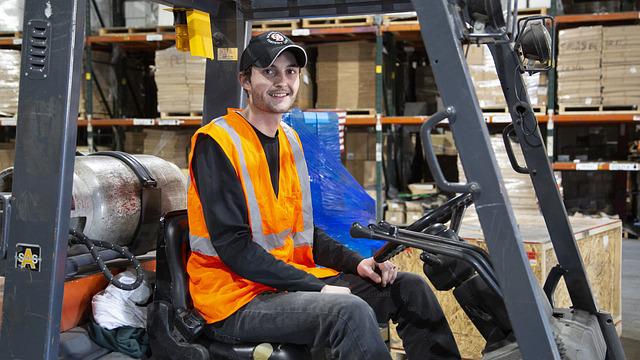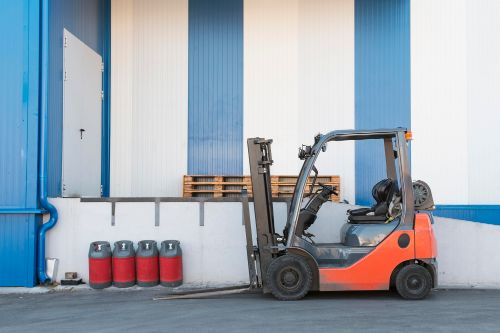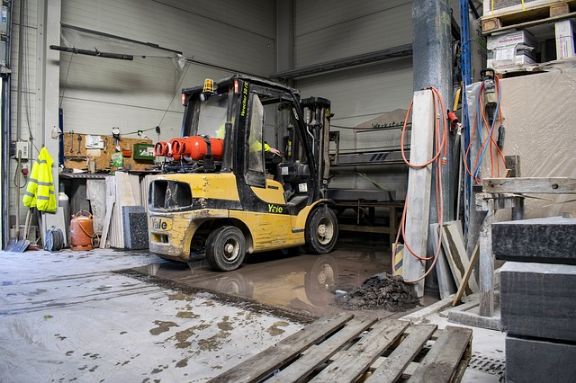
When selecting a propane tank for a forklift, it’s important to consider both the size of the tank and the requirements of your forklift. Generally, forklifts use propane tanks that range in size from about 33 pounds to 43.5 pounds. These sizes refer to the weight of the propane in the tank when it’s full, not the weight of the tank itself.
Most commonly, forklifts are equipped with a 33-pound tank, which is also referred to as an 8-gallon tank. This size is preferred due to its balance between capacity and ease of handling. The tank’s actual physical dimensions can vary, but they are typically designed to fit within the standard housing of a forklift.
It’s essential to ensure that the tank you choose is compatible with your forklift’s fuel system and mounting brackets. Safety is paramount when handling propane tanks, so always follow the manufacturer’s guidelines for installation and use.
Additionally, consider the frequency of use and the availability of propane refills when choosing the size of your tank. A larger tank can reduce the frequency of refills, but it also adds weight and may be more cumbersome to handle.
| Tank Type | Propane Weight (pounds) | Approximate Capacity (gallons) | Empty Tank Weight (pounds) | Dimensions (inches) | Refill Frequency | Cost Comparison | Common Usage |
|---|---|---|---|---|---|---|---|
| 33-pound Tank | 33.0 | 8 | Varies, typically around 25-30 | Varies, commonly around 12×18 | Moderate, depends on usage | Lower initial cost, higher refilling frequency | Most forklifts; balance between capacity and ease of handling |
| 43.5-pound Tank | 43.5 | 10 | Varies, typically around 30-35 | Varies, commonly around 12×28 | Less frequent, ideal for heavy usage | Higher initial cost, lower refilling frequency | For heavy usage or less frequent refilling; may be heavier and more cumbersome |
In summary, while the 33-pound (8-gallon) tank is most common for forklifts, the ideal size for your needs may vary depending on your specific circumstances and the design of your forklift. Always prioritize safety and compatibility when making your choice.
Will You Consider the 33 lb or the 43.5lb
The choice between a 33 lb and a 43.5 lb propane tank for your forklift depends on your specific operational needs and constraints. Here are some considerations for each:
33 lb Propane Tank:
- Smaller and lighter, making it suitable for forklifts with limited space or those that require greater maneuverability.
- Offers around 6-8 hours of operational time, which may be sufficient for lighter usage scenarios.
- Ideal for forklifts operating in confined spaces or those that require precise maneuvering.
43.5 lb Propane Tank:
- Larger capacity, providing approximately 8-10 hours of operational time, reducing the frequency of refills in high-use environments.
- Suitable for forklifts with more spacious operating areas and less concern about turning radius.
- Extended run time can improve overall operational efficiency in continuous-use settings.
The choice should align with your forklift’s specific requirements and the demands of your work environment. Assess your operational needs, available space, and any regulatory considerations to determine which propane tank size best suits your forklift. It’s also advisable to consult with propane suppliers or forklift manufacturers for tailored recommendations.
Compatibility of Different Tank Sizes with Various Forklift Models
When discussing the compatibility of different propane tank sizes with various forklift models, there are several critical factors to consider:
Technical Considerations for Tank Weight:
- Let’s say a forklift has a rated capacity of 5,000 pounds, and it’s designed for a standard 33-pound propane tank. If you replace this with a 43.5-pound tank, you’ve added an extra 10.5 pounds.
- This additional weight might seem small, but it affects the load the forklift can safely handle. For instance, the forklift’s effective load capacity might decrease, as the additional weight is often at the rear, increasing the load center distance from the front wheels.
Mounting Space and Design:
- Mounting Space Dimensions: Ensure the tank fits within the standard dimensions of the forklift’s tank bay, typically around 18 inches long, 12 inches wide, and 16 inches high, with a tolerance of ±0.5 inches.
- Attachment Point Specifications: Match the tank’s attachment lugs to the forklift’s bracket positions, usually with a lower bracket 6 inches from the base and an upper bracket 14 inches above, allowing a variance of ±0.25 inches.
- Tank Contour and Design: For contoured tanks, ensure the radius curvature (around 30 inches) aligns with the forklift’s frame for a snug fit.
- Clamp and Bracket Compatibility: Use clamps adjustable for tank diameters (12 to 14 inches) and capable of being tightened to a torque of 40-50 Nm.
- Safety Clearance: Maintain at least a 2-inch clearance around the tank in the bay for safety.
- Weight Distribution Analysis: A standard 33-pound tank should not alter the forklift’s center of gravity by more than 1 inch.
Fuel System Requirements:
- Pressure Ratings: Ensure the propane tank has a pressure rating of about 250 psi, with a pressure relief valve set around 375 psi to match the forklift’s system requirements.
- Connection Types: Use common connection types like ACME, with specifications such as a 1 3/4 inch diameter and 5 threads per inch, ensuring a secure fit with the forklift’s fuel system.
- Fuel Line Pressure: The forklift’s fuel line typically operates at 10 to 30 psi. The tank’s regulator must reduce the tank pressure to match this level, for example, from 250 psi down to 20 psi.
Impact on Maneuverability:
- Weight Impact: Upgrading from a 33-pound to a 43.5-pound tank adds around 10.5 pounds, potentially shifting the forklift’s center of gravity and affecting balance.
- Turning Radius: A larger tank could extend further (e.g., from 12 to 16 inches) from the forklift’s rear, increasing the turning radius by several inches and impacting maneuverability in tight spaces.
- Stability at Height: The shift in center of gravity is especially critical during lifting operations, affecting stability when the forks are raised.
- Space Considerations: In confined areas, like narrow warehouse aisles, even a slight increase in tank size can significantly affect the forklift’s ability to maneuver.
Operational Duration Considerations:
- Run Time: A standard 33-pound tank (about 8 gallons) typically offers 6-8 hours of use, while a larger 43.5-pound tank (around 10 gallons) can extend this to 8-10 hours, reducing refill frequency.
- Handling Impact: The larger size and weight of a bigger tank may affect the forklift’s maneuverability and stability, especially in tight spaces or during precise operations.
- Efficiency vs. Maneuverability: While larger tanks improve efficiency by reducing refueling needs, this benefit must be balanced with potential handling difficulties in constrained environments.
Safety Standards
- Pressure Standards:
- Propane tanks must adhere to pressure standards set by organizations such as the DOT (Department of Transportation) in the U.S. For example, forklift propane tanks are typically required to withstand a minimum pressure of 250 psi.
- Tank Certification and Markings:
- Tanks must display specific markings indicating compliance with safety standards. These include the manufacturer’s name, serial number, date of manufacture, and the applicable standard (e.g., “DOT-4E240” for a tank certified under DOT standards with a working pressure of 240 psi).
- Safety Valve Regulations:
- Safety relief valves are mandated to release excess pressure. The setting of these valves is critical and is usually around 375 psi, providing a safety margin above the operational pressure.
- Material and Construction Compliance:
- Tanks must be constructed from materials and through methods approved by regulatory bodies. For instance, steel tanks should comply with ASTM (American Society for Testing and Materials) standards for material strength and durability.
- Regular Inspection and Recertification:
- Propane tanks require regular inspections and recertification, typically every 5 to 10 years. These inspections ensure that the tank’s structure and valves remain in compliance with safety standards.
- Capacity and Labeling Requirements:
- The capacity of the tank (e.g., 33 pounds or 43.5 pounds of propane) must be clearly labeled, and the tank should not be filled beyond its rated capacity to comply with safety standards.
- Local and Industry-Specific Regulations:
- Compliance with local regulations and industry-specific safety standards is also essential. For instance, some industries or regions may have stricter standards regarding tank installation and handling.
Some Technical Specs to Know About
When discussing the technical aspects of fuel system requirements for forklift propane tanks, it’s vital to delve into specific numbers related to pressure ratings and connection types. Here’s a more technical explanation:
- Pressure Ratings:
- Propane tanks typically have pressure ratings that indicate the maximum pressure they can safely withstand.
- For instance, most forklift propane tanks are designed to handle pressures around 250 psi (pounds per square inch).
- It’s crucial that the tank’s pressure rating matches or exceeds the operating pressure of the forklift’s fuel system. Using a tank with a lower pressure rating than required can lead to a risk of tank rupture or failure.
- Pressure Relief Valves:
- Tanks are equipped with pressure relief valves, which are set to open at a specific pressure to prevent over-pressurization.
- For example, a relief valve might be set to open at 375 psi, which provides a safety margin above the operating pressure.
- Fuel Line Pressure:
- The pressure in the fuel line of the forklift’s engine system is also a critical factor. This is typically much lower than the tank pressure, often around 10 to 30 psi, depending on the engine’s design.
- A regulator is used to reduce the tank’s pressure to this operating level. Ensuring compatibility of the regulator with both the tank and the engine’s requirements is key.
- Connection Types:
- The type of valve and connection is also crucial. There are several standards in the industry, such as POL (Prest-O-Lite), ACME, and Type 1 (QCC).
- For instance, an ACME connection is a threaded connection commonly used in forklift tanks, known for its ease of hand tightening and safety features.
- Using the wrong type of connection can lead to leaks or inadequate fuel supply to the engine.
- Fuel Composition:
- The composition of the propane itself, measured in BTUs (British Thermal Units) per cubic foot, can affect engine performance. Standard propane is approximately 2,500 BTUs per cubic foot.
- Variations in fuel composition can affect engine tuning and efficiency, and the fuel system must be compatible with these variations.
When selecting a propane tank for a forklift, it’s essential to match the tank’s pressure rating and connection type with the requirements of the forklift’s fuel system. Using a tank with incompatible specifications can lead to fuel supply issues, poor engine performance, and potential damage to the fuel system. Technical diligence in ensuring compatibility is key to safe and efficient operation.
How Much Does a Propane Tank for a Forklift Cost?
The cost of a propane tank for a forklift can vary based on several factors such as the size of the tank, the material it’s made from, the brand, and where you purchase it. Here are some general price ranges:
- 33-pound Tanks: These are the most common size for forklifts. The price for a new 33-pound tank typically ranges from approximately $150 to $300. This variation depends on the quality and specific features of the tank.
- 43.5-pound Tanks: Larger tanks like the 43.5-pound ones are less common and might be slightly more expensive due to their larger capacity. Prices for these can range from around $200 to $350 or more.
- Used Tanks: The cost for used tanks can be significantly lower, but it’s crucial to ensure they are safe and meet all necessary regulations and standards.
- Rental Options: Some businesses opt to rent propane tanks instead of buying them outright. Rental costs can vary widely based on the terms of the rental agreement and local market rates.
Remember, prices can fluctuate due to market conditions, regional differences, and the specific supplier. It’s always a good idea to shop around and compare prices from different suppliers. Additionally, consider the long-term costs, including the price of propane refills and any maintenance or certification fees.
Forklift Can Take Either Aluminum or Steel Propane Tank
When deciding whether to use an aluminum or a steel propane tank for your forklift, it’s important to weigh the pros and cons of each material to determine which best suits your needs. Here’s some advice to guide you:
- Consider the Weight:
- Aluminum Tanks: They are lighter than steel tanks, which can make them easier to handle and change. The reduced weight may also slightly improve the forklift’s fuel efficiency.
- Steel Tanks: They are heavier, which might not be an issue for the forklift itself, but could be more challenging for personnel who have to change the tanks.
- Durability and Maintenance:
- Aluminum Tanks: These are less prone to rust and corrosion compared to steel. This can be particularly beneficial in humid or corrosive environments.
- Steel Tanks: While more susceptible to rust, if properly maintained, they can be very durable. Regular inspections and maintenance are more critical with steel tanks.
- Cost Implications:
- Aluminum Tanks: Generally, they are more expensive upfront than steel tanks. However, their longevity and lower maintenance needs could offset the initial cost over time.
- Steel Tanks: They are typically less expensive initially, but potential increased maintenance or earlier replacement should be factored into the long-term cost.
- Safety Considerations:
- Both aluminum and steel tanks are designed to be safe and comply with standard regulations. However, always ensure that whichever tank you choose meets the specific safety standards required for your operation.
- Compatibility with Your Forklift:
- Ensure that the tank you choose is compatible with your forklift model in terms of size, mounting, and fuel system.
If you prioritize ease of handling and resistance to corrosion and are willing to invest a bit more upfront, aluminum tanks might be the way to go. However, if the initial cost is a major factor and you are prepared to maintain them diligently, steel tanks can be a reliable and economical choice. Always consider the specific needs and conditions of your operation when making this decision.
Caution: Never Use a Regular Propane Tank on a Forklift
Using a regular propane tank designed for consumer use on a forklift is not recommended and can be unsafe. Forklifts require specialized propane tanks that are designed to meet safety and operational standards specific to industrial equipment. These specialized forklift propane tanks are constructed and certified to withstand the rigors of forklift operation and to ensure proper fuel delivery to the forklift’s engine.
Here are some key reasons why regular consumer propane tanks should not be used on forklifts:
- Safety Standards: Forklift propane tanks are manufactured to meet safety standards set by organizations such as the DOT (Department of Transportation). These standards include requirements for pressure ratings, materials, and safety features. Regular propane tanks may not meet these standards.
- Forklift Compatibility: Forklift propane tanks are designed to fit securely in the designated tank bay of the forklift. Using a regular tank may result in an insecure fit, increasing the risk of accidents.
- Fuel Delivery: Forklift propane tanks are equipped with a specialized valve and regulator to deliver propane to the forklift’s engine at the correct pressure. Using a regular tank with incompatible valves and regulators can disrupt fuel delivery and affect the forklift’s performance.
- Weight and Balance: Forklift propane tanks are designed to maintain the forklift’s proper weight distribution and balance. Regular tanks may be heavier or have different dimensions, which can impact the forklift’s stability and handling.
- Regulatory Compliance: Using non-compliant tanks can lead to regulatory violations and potential legal issues.
To ensure the safety and optimal performance of your forklift, it’s essential to use only propane tanks specifically designed and certified for forklift use. These specialized tanks are engineered to meet the unique requirements of industrial equipment and help maintain safe and efficient forklift operations.
To Make a Finalization
Selecting the appropriate size of a propane tank for a forklift is a crucial decision that involves evaluating operational needs, space constraints, safety standards, and installation specifications. It’s essential to strike a balance between extended operational time, maneuverability, weight, and compliance with regulations. By carefully considering these factors, you can make an informed choice that ensures both efficiency and safety in your forklift operations.
Additionally, it’s important to regularly inspect and maintain the propane tank to ensure its safe and efficient performance. Regular checks for leaks, damage, and compliance with safety standards should be part of your maintenance routine. This proactive approach helps prevent accidents and downtime, ensuring that your forklift operates smoothly and safely.
Lastly, keep in mind that specific recommendations for propane tank size may vary depending on your forklift model, industry regulations, and operational conditions. Consulting with a propane supplier or forklift manufacturer can provide valuable insights tailored to your unique requirements. Making an informed decision about the propane tank size is a key aspect of optimizing your forklift’s performance while prioritizing safety.

Mike is an experienced propane technician with over 15 years of professional experience in the field. He has dedicated his career to helping customers with their propane needs, from installation to maintenance and repair. Together with Jeremy, he co-founded this website to provide useful information and guidance to customers seeking reliable propane services.



